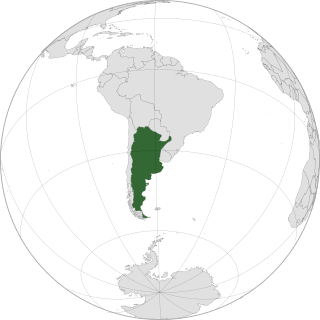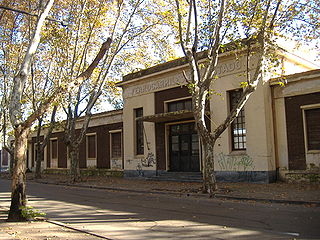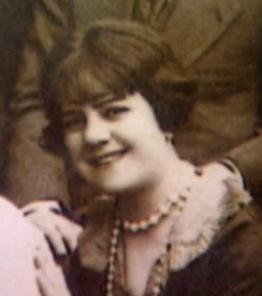
Rosario is the largest city in the central Argentina province of Santa Fe. The city is located 300 km (186 mi) northwest of Buenos Aires, on the west bank of the Paraná River. Rosario is the third-most populous city in the country, and is also the most populous city in Argentina that is not a capital. With a growing and important metropolitan area, Greater Rosario has an estimated population of 1,700,000 as of 2020. One of its main attractions includes the neoclassical, Art Nouveau, and Art Deco architecture that has been retained over the centuries in hundreds of residences, houses and public buildings.

The Cathedral Basilica Shrine of Our Lady of the Rosary is a minor basilica and cathedral dedicated to the local Virgin of the Rosary, in the city of Rosario, province of Santa Fe, Argentina. It is the mother church of the Archdiocese of Rosario.

This article is about the geography and urban structure of Rosario, which is the largest city of the province of Santa Fe, Argentina, and the third most populous in the country, after Córdoba and Buenos Aires. It is located about 300 km (190 mi) north of Buenos Aires, on the Western shore of the Paraná River, and it has about 910,000 inhabitants. It is surrounded by smaller cities and towns that form a metropolitan area with a population of about 1.2 million according to the 2001 census [INDEC].

The following is an alphabetical list of topics related to the Argentine Republic.

National Route 9 is a major road in Argentina, which runs from the center-east to the northwest of the country, crossing the provinces of Buenos Aires, Santa Fe, Córdoba, Santiago del Estero, Tucumán, Salta and Jujuy. It starts on Avenida General Paz, which marks the border between the Autonomous City of Buenos Aires and the surrounding province of the same name, and ends at the Horacio Guzmán International Bridge, on the La Quiaca River, traversing 1,967 km (1,222 mi). The road is a limited access motorway from Buenos Aires to Rosario.

Smoking in Argentina accounts for 15% of total tobacco consumption in the Americas. There are a number of smoking restrictions in place in different jurisdictions, and a nationwide governmental campaign against tobacco smoking and advertising. Since June 1, 2011 a smoking ban in all of Argentina prohibits smoking in workplaces, all public indoor areas, schools, hospitals, museums and libraries, theatres, and all public transport.

Paseo del Siglo is a part of the historical center of the city of Rosario, Argentina. It comprises eight blocks in the downtown Córdoba Street, from Oroño Boulevard east up to Paraguay Street. This segment and the adjacent streets showcase a number of historical buildings, from public and private institutions to former mansions of wealthy families. These have been preserved or restored under the sponsorship of a municipal preservation program.

Lesbian, gay, bisexual, and transgender (LGBT) rights in Argentina are among the most advanced in the world. Upon legalising same-sex marriage on 15 July 2010, Argentina became the first country in Latin America, the second in the Americas, and the tenth in the world to do so. Following Argentina's transition to a democracy in 1983, its laws have become more inclusive and accepting of LGBT people, as has public opinion.

Coronel Pringles is a city in the south of the Buenos Aires Province in Argentina, situated near the mountains of Pillahuincó. It is the government seat of the Coronel Pringles Partido.
The National Institute of Cinema and Audiovisual Arts is an agency of the Government of Argentina. It promotes the Argentine film industry by funding qualified Argentine film production companies and supporting new filmmakers. The Institute was established on 14 May 1968 by law nº 17.741. The INCAA also organizes the Mar del Plata International Film Festival, Ventana Sur film market, and has its own film school called ENERC.

Rosario is a railway station in Rosario, Santa Fe, Argentina. It is located at the junction of 27 de Febrero Boulevard and Juan Manuel de Rosas St., south of the city center.

Rosario Oeste is a railway station in Rosario, province of Santa Fe, Argentina. It is located in the west of the city, on the junction of Paraná St. and 9 de Julio streets.
The 8th Annual Latin Grammy Awards took place on Thursday, November 8, 2007, at the Mandalay Bay Events Center in Las Vegas, Nevada. The show aired on Univision. Juan Luis Guerra was the night's big winner, winning 5 awards including Album of the Year. Juan Luis Guerra was honored as the Latin Recording Academy Person of the Year one night prior to the telecast.

Plaza 25 de Mayo is a plaza in Rosario, province of Santa Fe, Argentina. It is Rosario's civic center, and the core of the original settlement. Its name alludes to the date of the May Revolution, which led to the establishment of the first local Argentine government in Buenos Aires. Before 1852, when this name was adopted, it was simply called Plaza Principal.

Plaza Santiago Montenegro is a small hardscape plaza in the city of Rosario, province of Santa Fe, Argentina. Its name honors one of the first Spanish-descended settlers in the area, Captain Santiago Montenegro. It was known as Plaza Pinasco until 1993.

The Argentina Bicentennial was a series of ceremonies, festivals, and observances celebrated on May 25, 2010, and throughout the year. They commemorated the 200th anniversary of the May Revolution, a sequence of historical events that led to the Viceroy Baltasar Hidalgo de Cisneros being ousted from office and replaced with the Primera Junta, the first national government.

8N is the name given to a massive anti-Kirchnerism protest in several cities in Argentina, including Buenos Aires, Córdoba, Rosario, Mendoza, Olivos, among many others throughout Greater Buenos Aires and other regions; on 8 November 2012. There were also protests in Argentine embassies and consulates in cities such as New York, Miami, Madrid, Sydney, Bogotá, Santiago de Chile, Naples, Zurich and Barcelona, among others. The protest is considered not only a call to Kirchnerism, but also to the opposition, because they did not have a strong leader.

Carmen Martínez Sierra was a Spanish actress.
















